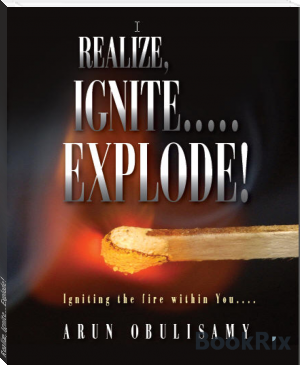Life is Full of Sweet Spots: An Exploration of Joy, Mary O'Connor [top novels txt] 📗

- Author: Mary O'Connor
Book online «Life is Full of Sweet Spots: An Exploration of Joy, Mary O'Connor [top novels txt] 📗». Author Mary O'Connor
Life is Full of Sweet Spots
An Exploration of Joy
By Mary O’Connor
Case in Point
Make Color and Light a Medium for Joy
BRIGITTE BRüGGEMANN
Rowe, New Mexico
Professional artist. Best way to experience joy: Be here, here and now.
Brigitte Brüggemann makes joy out of color and light. She creates it for herself through her paintings in oil, watercolor and pastels. She presents it to others through the vibrations in the soul that her works give.
Her recipe for joy, if there is a recipe, includes spontaneity, inspiration from nature and being in the moment, here and now. She has a firm belief in the power of art to change life, one moment at a time. Spontaneity, even wildness and unpredictability, is a big part of her joy.
Brigitte discovered the power of art as a youngster in Germany when her mother took her and her sisters to see the art and architecture. She recalls standing in front of Gruünewald’s famous Isenheim Altar, a particularly powerful 16th century painting depicting the crucifixion of Christ.
She remembers being struck by its power, not so much because of the iconography, which she recalls as being as cruel or as ugly as one could paint a person in suffering, but because it touched her soul. She saw how it could touch her and bring up an emotion, and decided then, as a young girl, that if a painting could have such a powerful effect, that was what she wanted to do.
Today, Brigitte is very clear in her purpose—"to be light and to paint light." Believing that the inner landscape of the self mirrors the outer landscape, she tries to make the visible invisible through color and lyrical abstractions, the symbolic abstractions being her own personal visual language. Her works, which usually draw from a conscious or unconscious source in her life, are noted for their rhapsodic use of color as well as for their brushstroke.
In Brigitte's words…
If you want to describe what happens technically, color is light. It causes vibrations in the soul. There is actually a chemistry happening with color and the surface of it. The passion I have for paint—what paint can do—is the vibration, I think. I look at art and a lot of it does not touch me. But there is something about the paint and its surface and the color that brings up vibration, and that brings us right back to color and light.
In the process of painting, I am allowing higher light frequencies to come into the painting through color. I can feel my own state of being changing into one of peace and joy. Color works on our psyche like music; the vibrations of color reach our unconscious and can change our moods dramatically. My choice of color is based always on the direct response I feel if I think of joy or sadness or uneasiness. In my painting, I stay away from most of those colors that make me cringe.
Right now, I’m sitting in my studio and I’m looking at this yellow painting. So yellow is something right now, but there are days where I do three red paintings right in a row, very deep red. White is always important for me because formally it sets off the colors. But also it is light, pure light. And then there are periods where I’m blue, where I’m doing blues, so it’s painting with whatever is happening.
When I start a painting, I look at the tubes lying there on the table and try to connect with my emotions, how I feel that morning. Then I pick three or four or five different pigments, like blues and a little orange and some yellows and some red and I squeeze them out on the palette and then I just watch the colors. So it’s based on emotion and I never know what will come out.
I can never have a plan. If I do have an idea, I start with one thing and it almost always has to get overpainted. If I start feeling precious about something, like a special brushstroke or a little area, and try to make the rest of the painting go with it, it almost never works. I usually end up taking that precious thing out and basically having to surrender to the will of the painting The surrender is not just for painting; I think it’s true for life.
It’s kind of a hard thing to describe, but I think it’s the dialogue. It’s like putting something on the painting and then suddenly the painting is yelling back at me and it says, No! When I start to listen to the painting, it almost paints itself. That’s the magic.
I live by the Pecos River. So I will walk down and sit on the bank and watch the water. It’s one of my greatest, greatest teachers, just to watch the flow. That’s another way I connect with spirit, just letting energy lead you along.
It’s almost like a pagan or animalistic kind of spirituality that if I go down to the river, the river has answers. If I have a question, I just sit there and I don’t know if the river actually tells me, but a tree would kind of wave at me or a bird would suddenly appear and it sort of brings me to a point where I realize that I’m a drop in the ocean to be part of all this. I feel separate in the city and so here I’m able to connect to that larger universe. It’s day and night. I look at the stars and I feel like I’m one of them, one of the stars.
I get great inspiration from nature and particularly from my garden. It’s like a paradise, a lost paradise that we found. It’s been a theme for me ever since my thesis when I got my Master’s. Nature is the greatest landscape architect of what naturally happens out there.
Here I live in the middle of New Mexico, which is considered wilderness or arid desert, and yet I have a beautiful garden. I have cultivated space and the wilderness is right outside the wall. A garden is cultivation—it’s manmade. So there is this constant contradiction there, and I used to feel guilty about that. But I don’t anymore, because I am who I am and creating beauty is my biggest passion in life.
The first thing I do each day—I get up and I treasure that ten minutes where I make my coffee and feed my cat and do those kind of morning things. Then I’ll go out with my cup and sit outside in the summer and I’ll just look around and listen. I have a little pond and I’ll look at the pond and the water and the fish and that is very soothing, too. So I walk very slow. It’s called the Zen walk, where you take very slow steps and try to observe everything and connect with it.
It’s like this loving touch and sometimes I’ll actually touch a flower and sort of give it a thought or even speak to it. And I’ll go down to the river. I’ll just walk very slowly. Being rushed by having to go somewhere, like having to go to the dentist, is the worst thing that can happen to me.
Peace is sort of an abstract term and it means a lot of different things to different people. For me, there’s almost a physical energy that moves through me that is just light and is untroubled and positive about what I can do and about what’s here and now.
Being present, I think, is the biggest bringer of joy. Just be here, here and now. Be in the moment. It’s about letting the past go, the stories go. Our thoughts for the future and memories of what has passed can so clutter up our emotions. It’s like a meditation. You don’t have to sit cross legged and on a cushion to mediate.
So if there is a recipe at all, or a program to get from point a. to b., I think the first thing is to create that space for the feeling of being at peace. Just look at that tree waving at you, or the flower, or whatever is right in front of you. Look at it and the thoughts will go. Empty the vessel, so joy can come in.
Purer colors...have in themselves, independently of the objects they serve to express, a significant action on the feelings of those who look at them.…A certain blue enters your soul. A certain red has an effect on your blood-pressure. ̶ Henri Matisse, French artist
Color Me Red – or Blue – or Yellow
The psychology of colors has long intrigued artists and psychologists alike. It is an inexact science, more of a study of the subjective effects various colors can have on our moods and feelings.
Although meanings can tend to vary by culture and by circumstance, some interpretations are fairly universal. Colors in the red area of the color spectrum, including red, orange and yellow, for example, are commonly known as warm colors, generating feelings of excitement, celebration, love, anger, aggression. Cool colors, including blue, purple and green, tend to be seen as evoking feelings of calmness, sadness or hopelessness.
What Do Colors Mean?
Red: Stimulating—represents power, strength, passion, courage, danger, energy
Pink: Brighter, hot shades are stimulating; paler shades are calming—represents sensitivity, friendship, romance and love
Yellow: Energizing—represents happiness, sunshine, joy, cheerfulness
Orange: Boosts self esteem—represents enthusiasm, fascination, creativity, determination
Blue: Calming—represents healing, loyalty, depth, wisdom, faith, heaven, tranquility
Purple: Alleviates nervousness—represents royalty, spirituality, creativity, mystery
Green: Relaxation—represents nature, serenity, healing, growth, fertility, hope, harmony, safety
Black: Depression—represents power, elegance, formality, evil, death, grief, security, fear
White: Tranquility—represents pureness, peace, light, goodness, purity, perfection, innocence
While there is perhaps a province in which the photograph can tell us nothing more than what we see with our own eyes, there is another in which it proves to us how little our eyes permit us to see. ̶ Dorothea Lange, documentary photographer
See with More than Our Eyes
Author Richard Louv has a delightful chapter in his most recent book, The Nature Principle, in which he writes of talking, singing, sniffing the air, watching for tracks, even feeling the hair on the back of the neck stand up, as ways to sense the presence of bears. When we think of seeing, we tend to single out our eyes. But eyesight is a complex gift, one that joins with a long list of other human senses in the reception of meaningful images.
Most of us probably are not too worried about refining our ability to perceive the presence of bears. To be able, however, to experience other images to the fullest, to grasp and comprehend their meaning, to delight in the full phenomenon of their beauty, is undoubtedly a capability we want to make the most of. Sight serves as the window into some of life's richest sweet spots.
Imprint





Comments (0)